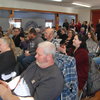Knox hopes to protect farmland, merging conservationists with farmers
KNOX — To help preserve what is arguably the town’s most valuable resource, the Knox Farmland Protection Committee is exploring the idea of a plan that would identify key threats to the town’s agricultural identity while also pointing out how to best mitigate them.
Knox Agricultural Advisory Committee Chairman Gary Kleppel, a sheep farmer and retired professor, told The Enterprise this week that he and Knox Conservation Advisory Committee Chairman Eric Marczak had worked together to get approval from the town board for the new five-member steering committee, which is made up of members from both of their groups, as well as interested residents.
Kleppel said that it’s significant for the two committees to join forces in this way since the interests of agriculturalists and conservationists have “for so long been at odds with one another, and we’re working to create an agricultural model in the town of Knox that’s consistent with both agriculture and conservation.”
While they may have been opposed in the past, the two perspectives now share some common enemies: namely developmental pressures and climate change.
Kleppel said that he was told in conversation with a representative from the New York State Department of Agriculture and Markets that, over the next 30 years, “the main crop coming out of Knox will be houses.”
“That’s how it was explained to me,” Kleppel said.
Meanwhile, the changing climate is actively impacting crop quality, which in turn impacts the growth of livestock, and farmers’ bottom lines, he said.
“It’s already affected the price of our hay,” Kleppel explained, “and the availability and quality of hay that I feed my animals … An orchard a few years ago had one harvest in four years, and the orchard farmer said to me, ‘Bringing in one crop in four years, that’s not farming.’ So that’s a real problem.”
Kleppel said that the Knox plan will include a SWOT analysis — strengths, weaknesses, opportunities, and threats — to help the town get a clearer sense of what the farming community is facing.
He said that about a third of the town is made up of farmland, and that agriculture is a major part of Knox’s cultural and economic identity.
Loss of farmland — particularly that belonging to independent farmers — is not unique to Knox.
According to the United States Department of Agriculture’s most recent ag census, from 2022, Albany County had 54 fewer farms that were between one and 179 acres that year than in 2017, and at least 1,478 fewer harvested acres in that category overall. Statewide, there were roughly 2,800 fewer farms and a loss of 364,000 acres in the same five-year period.
The Enterprise has reported before on the Knox Agricultural Advisory Committee's efforts to stem the tide locally by encouraging farmers to create transition plans for their operations so that, when they stop farming, their capital can go to a younger generation and keep the land productive.
Kleppel this week recounted a story he heard from one of the committee members who, at a farmer’s funeral, had heard one of the farmer’s children ask what their dad would have wanted them to do with the farm.
“That’s not good,” he said of not having a clear path forward.
In addition to laying out initiatives like farm transitions, Kleppel said the Knox plan will aim to figure out “how much farmland is being created, how much is being lost, where that farmland is, and what’s being done.”
Developing the plan will be a long-term project with many moving parts, he said. Right now, the committee is focused on putting together a proposal to send to New York state in hopes of getting some funding, which likely won’t happen until early next year.
The state may provide up to $25,000, with in-kind contributions potentially coming from the county and the town itself, for a rough total of about $30,000, Kleppel estimated.
But it will be worth it, he suggested, to have a plan that is “one of the most important opportunities to let our representatives, some of whom are farmers and some of whom are not, know what farmers need in order to have a reasonable livelihood, to keep their children in clothes, and do the things they need to do for their families.”



